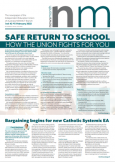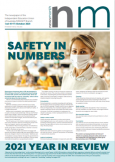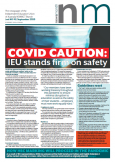The union is concerned that some employers are considering the consolidation of resources, including the amalgamation of two schools, with a diminished leadership structure. These decisions seem to be driven primarily by financial considerations.
When an employer decides two schools will amalgamate and/or operate under the leadership of a single principal, there are implications for staff. This transition can bring about challenges that need to be managed with careful planning, transparent communication, and supportive leadership.
One of the immediate effects of amalgamation is an increase in workload. A single principal overseeing two campuses or schools often means added responsibilities, not just for the principal but also for?the staff.
With the need for greater co-ordination and support across both campuses, administrative and teaching staff may find themselves taking on additional tasks, leading to increased stress and longer working hours.
Amalgamation can also raise concerns over redundancy, particularly for administrative and support staff whose roles may be duplicated across the two schools.
Each school has its own unique culture and merging them can sometimes create friction. Staff from both schools might struggle to adapt to a new culture, which can affect morale. The loss of each school’s individual identity often leads to resistance to change, making it crucial for leadership to be sensitive to the emotional aspects of the transition.
Clear communication
Communication becomes more complex when co-ordinating activities, events and meetings across two campuses. Clear communication is vital to ensure that all staff are on the same page, aware of changes, expectations and policies. Leadership must prioritise the development of a robust communication strategy to keep staff engaged and informed throughout the amalgamation process.
The changes brought about by amalgamation may also necessitate additional professional development. New systems, processes and expectations can be challenging, and training sessions or workshops can help staff adapt to new ways of working. Providing support mechanisms, such as counselling services or peer support groups, is equally important to ease anxieties during the transition.
Positive learning environment
The way amalgamation is managed can have a direct impact on student-teacher ratios, class sizes and resource allocation. Teachers may need to adapt to changes in student demographics, class compositions, and teaching environments. It is essential to ensure these changes do not compromise educational quality, as maintaining a positive learning environment for students should remain a priority.
Coordinating schedules, events and curricula across two campuses presents logistical challenges that require planning and additional resources. Issues related to facilities management, such as maintenance, transportation between sites, and resource allocation, also need to be addressed.
The stress and uncertainty associated with amalgamation can also impact staff wellbeing. Maintaining a focus on mental health is essential for fostering a supportive and resilient work environment.
Upholding rights
Amalgamation may also affect staff contracts, union agreements and terms of employment, which need to be negotiated to avoid disputes. Ensuring compliance with existing agreements and keeping staff informed and involved throughout the process will help build trust and reduce the risk of conflict.
Open dialogue with the IEU and its representatives is a necessity to aid in a smoother transition by addressing concerns and ensuring staff rights are upheld.
The success of any amalgamation effort will rely on thorough consultation with the union and its members, along with strong leadership from the employer that prioritises clear communication, professional development, and staff wellbeing.












































































































































